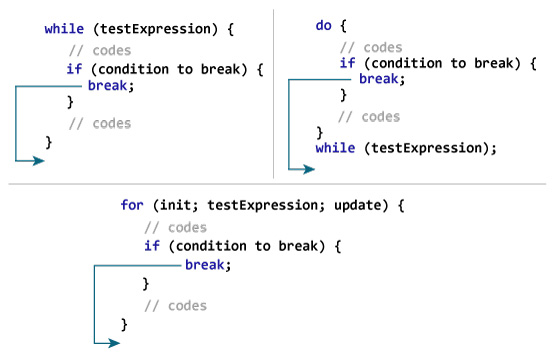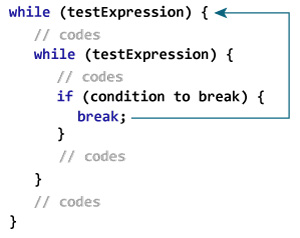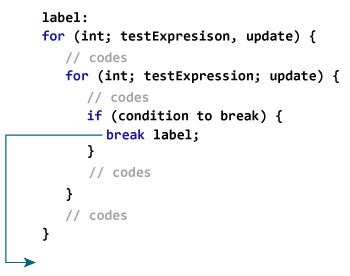使用循环时,有时希望跳过循环内的某些语句或立即终止循环而不检查测试表达式。
在这种情况下,将使用break和continue语句。您将在下一章中了解d。
Java中的break语句立即终止循环,程序的控制移至循环后的下一条语句。
它几乎总是与决策语句(Java if … else语句)一起使用。
这是Java中break语句的语法:
break;break语句如何工作?

示例1:Java break语句
class Test {
public static void main(String[] args) {
// for loop
for (int i = 1; i <= 10; ++i) {
// if the value of i is 5 the loop terminates
if (i == 5) {
break;
}
System.out.println(i);
}
}
}输出 :
1
2
3
4在上面的程序中,我们使用for循环在每次迭代中打印i的值。要了解for循环的工作原理,请访问Java for循环。在这里,请注意以下声明:
if (i == 5) {
break;
}这意味着当i的值等于5时,循环终止。因此,我们得到的输出值仅小于5。
示例2:Java break语句
下面的程序计算用户输入的数字总和,直到用户输入负数。
为了接受用户的输入,我们使用了Scanner对象。要了解有关Scanner更多信息,请访问Java Scanner。
import java.util.Scanner;
class UserInputSum {
public static void main(String[] args) {
Double number, sum = 0.0;
// create an object of Scanner
Scanner input = new Scanner(System.in);
while (true) {
System.out.print("Enter a number: ");
// takes double input from user
number = input.nextDouble();
// if number is negative the loop terminates
if (number < 0.0) {
break;
}
sum += number;
}
System.out.println("Sum = " + sum);
}
}输出 :
Enter a number: 3.2
Enter a number: 5
Enter a number: 2.3
Enter a number: 0
Enter a number: -4.5
Sum = 10.5在上面的程序中, while循环的测试表达式始终为true 。在这里,请注意这行,
if (number < 0.0) {
break;
}这意味着当用户输入负数时,while循环终止。
Java中断和嵌套循环
在嵌套循环的情况下, break语句终止最里面的循环。

在这里,break语句终止了最里面的while循环,并且控制跳到了外部循环。
标记的中断声明
到目前为止,我们已经使用了未标记的break语句。它终止最里面的循环和switch语句。但是,Java中还有另一种break语句形式,称为带标签的break。
我们也可以使用标记的break语句终止最外面的循环。

如您在上图中所看到的,我们已经使用标签标识符来指定外部循环。现在,请注意break语句的用法( break label; )。
在这里, break语句终止了标记的语句(即外循环)。然后,程序的控制跳到标记语句之后的语句。
这是另一个例子:
while (testExpression) {
// codes
second:
while (testExpression) {
// codes
while(testExpression) {
// codes
break second;
}
}
// control jumps here
}在上面的示例中,当语句break second;执行完后,标记为Second的while循环终止。并且,程序的控制权在第二个while循环之后移至该语句。
示例3:标记的break语句
class LabeledBreak {
public static void main(String[] args) {
// the for loop is labeled as first
first:
for( int i = 1; i < 5; i++) {
// the for loop is labeled as second
second:
for(int j = 1; j < 3; j ++ ) {
System.out.println("i = " + i + "; j = " +j);
// the break statement breaks the first for loop
if ( i == 2)
break first;
}
}
}
}输出 :
i = 1; j = 1
i = 1; j = 2
i = 2; j = 1在上面的示例中, labeled break语句用于终止标记为first的循环。那是,
first:
for(int i = 1; i < 5; i++) {...}在这里,如果我们更改语句,则break first; break second;该程序的行为将有所不同。在这种情况下,标记为second的for循环将终止。例如,
class LabeledBreak {
public static void main(String[] args) {
// the for loop is labeled as first
first:
for( int i = 1; i < 5; i++) {
// the for loop is labeled as second
second:
for(int j = 1; j < 3; j ++ ) {
System.out.println("i = " + i + "; j = " +j);
// the break statement terminates the loop labeled as second
if ( i == 2)
break second;
}
}
}
}输出 :
i = 1; j = 1
i = 1; j = 2
i = 2; j = 1
i = 3; j = 1
i = 3; j = 2
i = 4; j = 1
i = 4; j = 2 注意 : break语句还用于终止switch语句内的大小写。要了解更多信息,请访问Java switch语句。